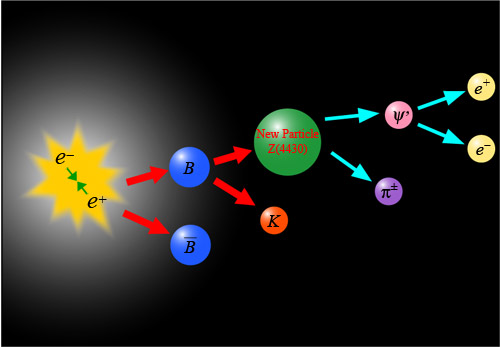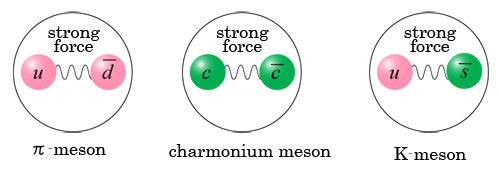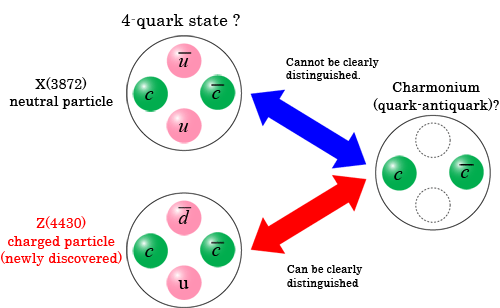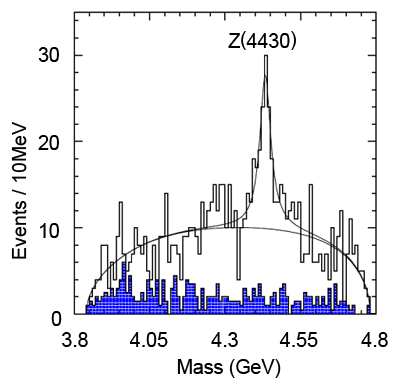An international team of researchers at the High Energy Accelerator Research Organization (KEK) in Tsukuba, Japan, the "Belle collaboration"*1, recently announced the discovery of an exotic new sub-atomic particle with non-zero electric charge. This particle, which the researchers have named the Z(4430)*2, does not fit into the usual scheme of "mesons", combinations of a quark*3and an antiquark that are held together by the force of the strong interaction.
The Z(4430) particle was found in the decay products of B-mesons (mesons containing a "bottom" quark) that are produced in large numbers at the KEKB "B-factory", an electron-positron collider at the KEK laboratory. While investigating various decays of the B meson in a data sample containing about 660 million pairs of B and anti-B mesons, the Belle team observed 120 B mesons that decay into a Z(4430) and a K-meson. The Z(4430) then instantly decays into a "Psi-prime" ( ) particle and a pi-meson (see Figure-1). The Belle team found that this particle has the same electric charge as the electron and a mass about 4.7 times that of the proton. ) particle and a pi-meson (see Figure-1). The Belle team found that this particle has the same electric charge as the electron and a mass about 4.7 times that of the proton.
In the past few years, a number of peculiar new particles, including the so-called X(3872), Y(4260), X(3940), Y(3940), have been found by the Belle and also by the BaBar experiment at the Stanford Linear Accelerator Center (SLAC). These new particles lie in the mass region from 4 to 4.5 times the proton mass, and decay into "J/psi" or "Psi-prime" particles and pi-mesons. Here J/psi and Psi-prime particles are examples of so-called "charmonium" mesons, bound states of a charm quark and its anti-particle (an anti-charm quark). Since the masses and the decay properties of these new particles do not match theoretical expectations for quark-antiquark combinations, theorists around the world have proposed other potential explanations, which include the possibility that some are made up of four quarks (for example, a combination of a charm quark, an anti-charm quark, an up quark and an anti-up quark). However, since all of these new particles are electrically neutral, it was not experimentally possible to rule out alternative explanations of the new states as excited charmonium mesons.
On the other hand, the newly discovered Z(4430) state has non-zero electric charge, a characteristic that clearly distinguishes this particle from normal quark-antiquark mesons; it, therefore, must have a charm quark, an anti-charm quark and at least two more quarks (for example, an up quark and an anti-down quark). Thus, the Z(4430) does not fit into the framework of known mesons. As a result it has attracted a considerable amount of attention from the world's physics community (Figures 2 and 3).
Single quarks cannot be isolated. Instead, quarks are confined in composite particles such as mesons. This is a characteristic feature of the strong force, described by a mathematical theory called "Quantum Chromo-Dynamics (QCD)". The discoveries of sub-atomic particles at the KEK B-factory provide an experimental foundation for better understanding of the phenomena of quark confinement as well as the formation of matter in QCD.
The discovery of the Z(4430) is described in a paper submitted on October 22 to Physical Review Letters, a leading physics research journal.
[ Media Contact ] Youhei Morita, KEK Public Relations Office
+81 29-879-6047
|
 |
Figure 1 : The new particle Z(4430) is produced together with the K-meson from decays of the B meson, and instantly decays into a psi-prime particle( ) and a pi-meson. ) and a pi-meson.
|
 |
Figure 2 : Normal mesons are composite particles made up of a quark and an anti-quark bound together by the strong force. A meson made from a charm quark and anti-charm quark pair is called "charmonium".
|
 |
Figure 3 : The X(3872) particle, which is electrically neutral, cannot be clearly distinguished from an unusual charmonium meson. On the other hand, the newly found Z(4430), which is electrically charged, can be clearly distinguished from all charmonium mesons.
|
 |
Figure 4 : Distribution of the measured mass for combinations of a detected pi-meson and a psi-prime meson. The Z(4430) is visible as the peak at 4430 MeV.
|
| |
| *1: | The "Belle collaboration" is an international team of about 400 faculty and student researchers from 55 institutes (universities and laboratories) located in 14 different countries and regions. |
| |
| *2: | In particle physics, it is conventional to label particles with Roman or Greek symbols. The newly discovered particle is called "Z" to distinguish from other particles in the same mass range. The value in parenthesis indicates the mass in units of MeV (million electron volts). |
| |
| *3: | Quarks are the most fundamental particles that form matter. Six types are known; these are classified into three generations. The six types are [up, down] [charm, strange] and [top, bottom]. The up, charm and top quarks have electric charge of +2/3 e, while the down, strange and bottom quarks have charge -1/3 e, where "e" is the charge of the electron. Each quark has its anti-particle partner with the same mass and opposite electric charge. |
| |
| Quark |
|
Antiquark |
| Charge | Generation |
| I | II | III |
 |

up |

charm |

top |
 |

down |

strange |

bottom |
|
|
| Charge | Generation |
| I | II | III |
 |

anti-up |

anti-charm |

anti-top |
 |

anti-down |

anti-strange |

anti-bottom |
|
|
|



